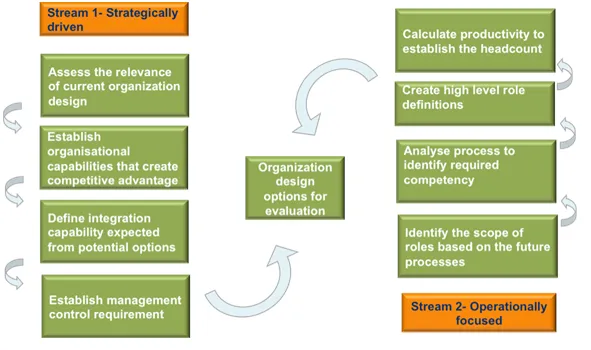
Nov 2, 2018 | 3 min read
Eight steps to create a new Organization Design
To transform an organization, the most often used levers by a business leader are setting the strategy and appointing the right people to operationalize the business vision. Though good people are important, they do not work in isolation. The organization design defines structures, processes, metrics and reward systems, and people practices that will ensure that individual and organizational energy is focused on those activities that support the achievement of the strategy.
Organization Design is the means for creating a community of collective effort that should yield more than the sum of each individualʼs efforts and results. The organizationʼs structures, processes and practices channel and shape peopleʼs activities and energy. The values and culture of the organization influence interpersonal interactions and determine which decisions get made. The form of the organization can enable or inhibit peopleʼs innate desire to do good work on a daily basis. It is important to create an optimal organization design that serves the business strategy and makes it easier for people to collaborate, innovate and achieve.
Organization Design Approach
There are two distinct starting points for redesigning any organization: Strategically driven top down or operationally focused bottom up. Both the approaches have its pros and cons and in our experience, we have realized that they are not mutually exclusive. Any dynamic organization needs to have a clear vision and a strategy that realizes the vision.
The strategy directs the identification of organizational capabilities that in turn determine the operating model. However, to maintain the balance between a grand vision and operational realities, it is important to ensure that the operating model caters to day to day ease of working, smooth communication channels, quick decision making and responsiveness to any change in the external environment. A hybrid approach that combines the positive aspects of both the approaches is shown in the figure below.
There are two distinct streams of work that can be carried out simultaneously, which contribute together for identifying design options.

Design of an organization is not an exact science. Hence the main thrust of this approach is to define design criteria accepted by the organization and propose options that can be evaluated by the executive team based on the identified criteria. It is imperative to ensure all design requirements and organizational constraints are captured as design criteria and the deliberations of the executive team are facilitated to pick the most optimal design. There are two distinct streams of work that can be carried out simultaneously, which contribute together for identifying design options. Each step shown in the figure above is described below.
Stream 1- Starting from the top
1. Assess the relevance of current Organization Design
The Current State Assessment (CSA) provides a snapshot of the strengths and weaknesses of the organization at a point in time. This provides important information on baseline conditions and helps determine what changes will have the greatest positive impact on the organization. This is a way to surface the ideas for improvement that are latent throughout the organization. This is a crucial link between the needs of the organization and the design process. It is important to select a representative sample of workforce across different levels as respondents to questionnaire or interview candidates to obtain an overall perspective of the current design flaws. The following questions need to be answered by CSA
Do people have to work with others outside their own department but find it difficult to cross-organizational boundaries?
2. Establish organizational capabilities that create competitive advantage
Does the structure create barriers to working with people outside the organization (e.g. internal and external customers, key suppliers, business partners)? Are there groups that should be combined into new departments? Is there a logic and a rationale for each of the pieces (departments, units) or have they just grown organically ( or represent past political decisions ) ? Are there overlaps between the roles of the departments or Units? Having understood the current design limitations, the next important thing to understand is the competitive advantage that the organization aims to create. To put it simply, if the strategy of the organization is to provide excellent customer service through increased customer responsiveness, it needs to concentrate on building a structure that is customer facing externally and is internally supported by an integrated end-to-end process run on ERP system owned by the customer service team. Organizational capability is defined as an integrated set of skills, technologies and human abilities that create competitive advantage for the organization. Generally, there are 3 areas in which competitive advantage can be gained- product, customer, and operations.
3. Define integration capability expected from potential options
Success of an organization design depends on how well various units of the organization work together. Integrative processes support the main operating model of any organization. They provide information and shape decisions in order to coordinate activities spread out across different units of the organization. They are the business and management processes that provide value to the customers and get work done. Although numerous processes exist within any organization, typically there are three to five that are critical to the business and involve multiple parts of the organization to carry them out. For a strictly product focused company, new product development, innovation management, market research and intelligence might be essential processes. For a customer organization, relationship management, knowledge management, and solution development processes might be important. These integrative processes can be defined in the organization design as a separate function or additional responsibility.
4. Establish management control requirement
A crucial input to any design exercise is the number of layers of management and right span of control. There is no one right answer to this question. Layers and spans are structured to help managers get work done, so the decision on the number of management layers and the span of a managerʼs control requires discussions and agreement on what managers are there to do. To help get a good enough answer to the “how many layers” question, there are four rules of thumb (related to the four management activities of planning, coordinating, controlling and allocating). Each layer should:
1.Be flexible and adaptable enough to enable managers to forward plan in a context of constantly changing operating environments;
2.Facilitate co-ordination between units (There are six forms of business unit to unit co-coordinating activity; leveraging know-how; sharing tangible resourcesʼ; delivering economies of scale; aligning strategies; facilitating the flow of products or services; creating new business)
3.Have appropriate control and accountability mechanisms ( note that any task, activity, or process should have only one person accountable for it and accountability and decision-making should be at the lowest possible level in the organization; overlap and duplication, fuzzy decision-making and conflict resolution processes are all symptoms of lack of adequate controls );
Stream 2- Bottom up analysis
1. Identify the scope of roles based on the re-engineered processes
Before defining any roles in the new organization design it is essential to clarify the scope of the roles. A good way to get clarity on the scope of roles is by creating operational process flowcharts swimlaned as per role.
2. Analyze each process step to articulate tasks and related competency
A detailed task analysis needs to be carried out to assess impact of process change on the roles and requisite competencies. To capture the competencies required for each manual task, task analysis interview need to be carried out with process owners. It is possible to present all identified competencies as a competency dictionary for the organization for future reference. This information can then be used to identify new roles by collating all related tasks.
3. Group tasks to create role definitions
To create role definitions all related tasks should be brought together and related competencies should be collated. The swimlaned process charts and task analysis document should be used together to identify relevant roles in the new organization design.
4. Calculate productivity to establish the headcount
A headcount analysis needs to be carried to establish headcount required to handle expected volumes at the productivity defined by new processes. This also provides critical input to span of control discussions. Theoretically, an organization can be structured in a limited number of ways- by product, by function, by geography or in a matrix. Practically, the structure is always a hybrid of these options. Following the steps mentioned above will provide the team, entrusted with creating a new organization design, enough information to evaluate the potential options. It is only through deliberations on the data collated and building a consensus with the senior executives that a final organization design can be created.
More Blogs

May 15, 2018 | 3 min read
6 valuable Business Lessons the sitcom “F.R.I.E.N.D.S” taught us
Like everyone else in the world, I am a huge fan of the 90’s sitcom Friends...
Read More
May 15, 2018 | 3 min read
6 entrepreneurship lessons from my 11-month old daughter!
Babies are born entrepreneurs. They step into unchartered territory with enviable confidence...
Read More
May 15, 2018 | 3 min read
6 valuable business lessons that my clients taught me
Happy 6th birthday, PeopleWiz! It’s that day again when we take a pause and look back...
Read MoreDelivering the future of workplace